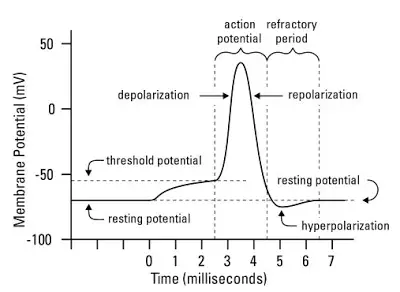Bioelectric potentials
The ionic voltages produced as a result of the electrochemical activity of certain special types of cells are called as Bioelectric potentials.
Resting & Action Potentials
Our body is made up of different kinds of cells. The cell is the smallest unit of a living thing. The cell is surrounded by a semipermeable membrane that permits some substances to pass through the membrane while blocks other.
- The cell is surrounded by body fluids and contains charged atoms like sodium (Na+), potassium (K+), and chloride (Cl–).
- The semipermeable membrane permits entry of (K+) and (Cl–) but effectively blocks the entry of (Na+) ions.
- Now charges want balance in terms of charge and concentration inside and outside of the cell.
- Since sodium ion is positive and due to less concentration of sodium inside the cell, the outside is more positive compared to inside.
- So to balance charge concentration, more potassium ions move inside the cell. But due to this, potassium concentration inside the cell is more than outside.
- So neither charge nor concentration balance takes place.
- So an equilibrium is reached with a potential difference across the membrane, negative on the inside and positive on the outside.
This semipermeable membrane potential is known as Resting Potential of the cell. Resting Potential varies from – 60 to – 100 mV for different cells. A cell in the resting state is said to be polarised.
If this cell is excited by some external energy or by the flow of ionic current, the semipermeable membrane changes its characteristic properties. Now it allows entry of sodium ions inside the cell.
- There is an ionic current due to the movement of sodium ions inside the cell that further reduces the barrier of the membrane to sodium ions.
- There is an avalanche effect where sodium ions move inside rapidly to equate concentration inside as well as outside the cell.
- The concentration of potassium ion inside is greater than outside the cell. Therefore, potassium ion move outside the cell.
- An equilibrium is reached with a potential difference across the membrane, negative on the outside and positive on the inside.
This semipermeable membrane potential is known as Action Potential of the cell. Action Potential is approx. +20 mV for cells. A cell that has been excited and that displays an action potential is said to be depolarised. The process of changing from the resting potential state to the action potential state is called as depolarization.
The process of changing from action potential or depolarised state to the resting state is called as repolarization.
 |
| Fig. Resting & Action Potentials |
The period of time in which the cell does not respond to any new stimulus is called as the absolute refractory period. It lasts for 1 msec in nerve cells.
The period of time after the absolute refractory period in which the cell respond to a new stimulus such that an action potential can be triggered is called as the relative refractory period.
When a cell is excited and generates an action potential, it also excites its neighbouring cell.This action potential propagates from one cell to another.
The rate at which an action potential moves from one cell to another cell is known as the propagation rate.
In nerve cells, propagation rate is also known as nerve conduction rate. Example. Nerve conduction rate usually varies from 20 to 140 m/s.
Different cell generates action potential of different magnitude. So bioelectric potential of a muscle cell or nerve cell or any cell gives information about normal and abnormal working of the system. A transducer is used to measure bioelectric potential by converting ionic potentials and currents into electric potential and current. It has electrodes to measure the potential.
